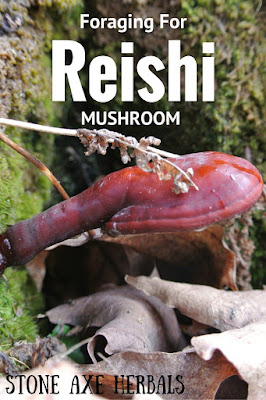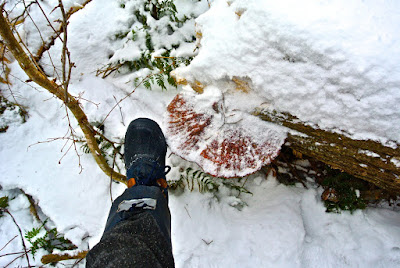Foraging For Reishi Mushroom
Found all over the world, reishi mushroom has long been prized for its medicinal properties. Like chaga, another medicinal mushroom that we love here at Stone Axe Herbals, reishi (pronounced ray-she) is an adaptogen. Although it is much more complicated than this, basically that means that it helps your body to cope (adapt-ogen) with whatever life throws at it. I personally like to use it for extra immune support, especially during times of stress.
For more information on the medicinal benefits of reishi, visit the Memorial Sloan Kettering Cancer Center website.
There are many species of reishi in the genus Ganoderma that grow around the world and are very closely related. Here in the United States we have just a handful that grow wild:
Ganoderma lucidum- found mostly in Southern U.S. on hardwoods
Ganoderma tsugae- found in Northern U.S., mainly on hemlocks
Ganoderma curtisii- found in Southeastern U.S. on hardwoods
Ganoderma oregonense- found in Pacific Northwest on conifers
Here are two great websites about the growth of wild Ganoderma in the United States:
http://botit.botany.wisc.edu/toms_fungi/mar2005.html
http://tcpermaculture.com/site/2014/02/20/reishi-ling-chi-mushroom/
I am going to be focusing on Ganoderma tsugae, just because it is the most common reishi here in Vermont. While it can be found on most conifers in general, I have only seen it grow on dead hemlock logs and stumps.
Last years reishi grown on a hemlock log.
I go out while there is still snow on the ground to search for reishi in hemlock forests. This way, I can take note of where I find them in the winter before the growing season starts and then go back in the summer to harvest the new growth. Reishi grows new fruit every year, this is what you want to harvest as older reishi do not have nearly the medicinal content as new mushrooms. It is easy to tell this years reishi from the last because last years will often be dull colored and eaten by bugs.
See how these reishi are dull in color and not shiny and how they have been eaten badly by insects?
New growth on reishi is white and soft and you can see it on the edges of the mushroom. While most people do not eat reishi because it is hard and bitter, this white edge material can be cut off and eaten while still soft. If you see any white flesh on the reishi, it is a good indication that it is currently growing or will grow more in the future.
Although small and brightly colored this reishi is definitely still from last year. Not only because I found it well before the growing season had started but because it has no white flesh on the edges.
These are some Ganoderma lucidum I am growing on hardwood sawdust inside. You can see that most of the young antlers are white. This is the new growth.
Here is Vermont, reishi begins to grow in May-June and continues to grow throughout the summer. The best time to harvest it is when you notice that the reishi's brown spores are dusting the tops of them. At this point, they are fully mature and ready to be picked. To do so, cut it off at the stem using a sharp knife. Be sure to put them in a mesh bag so that the spores are spread as you walk through the woods with them, making more reishi! Reishi can grow on the same log for up to 10 years so remember your spots so you can come back next year.
Once you've harvested your reishi you are probably going to want to cut it up into strips right away. Reishi hardens as it dries and it will be nearly impossible to cut at that time. You do need to dry it though! Like all medicinal mushrooms, reishi can go bad if the moisture content is too high. To dry, simply cut into strips and leave out to dry in the sun on a warm dry day. You can also put it in a food dehydrator for a couple of hours on the lowest temperature. I would not recommend drying them in the oven as the temperature is too high and could damage the medicinal components of the mushroom.
Lucky for us, there are very few mushrooms that look even close to reishi and those are not harmful. As always when harvesting wild mushrooms, be sure to try just a small amount and wait 24 hours to see if you have any side effects before eating more.
The best way to tell reishi from other species is by its stem. Reishi are kidney shaped and grow from the log or stump on a stem.
See the stems on these two reishi mushrooms above?
While this mushroom has a white edge and reddish-brown top, upon closer inspection you can see that it is not growing from a stem but directly from the tree.
Looking for more information on reishi mushroom? Check out these great resources:
Disclaimer: This blog is just my own opinion, nothing more. While I try my hardest, everything may not be completely accurate or complete. Sorry, I'm only human, so do not hold me accountable for anything you do to harm yourself or the world around you. I do make money from this blog (seriously not very much at all guys). If you click on any of the links in my blog I may make money from it. I'm not sponsored by any of these people I just honestly love these products and want to give you the resources to find them. I am not a medical practitioner; consult a health professional before using any herbal remedies. I am not claiming to diagnose, treat, prevent, or cure any ailment.









